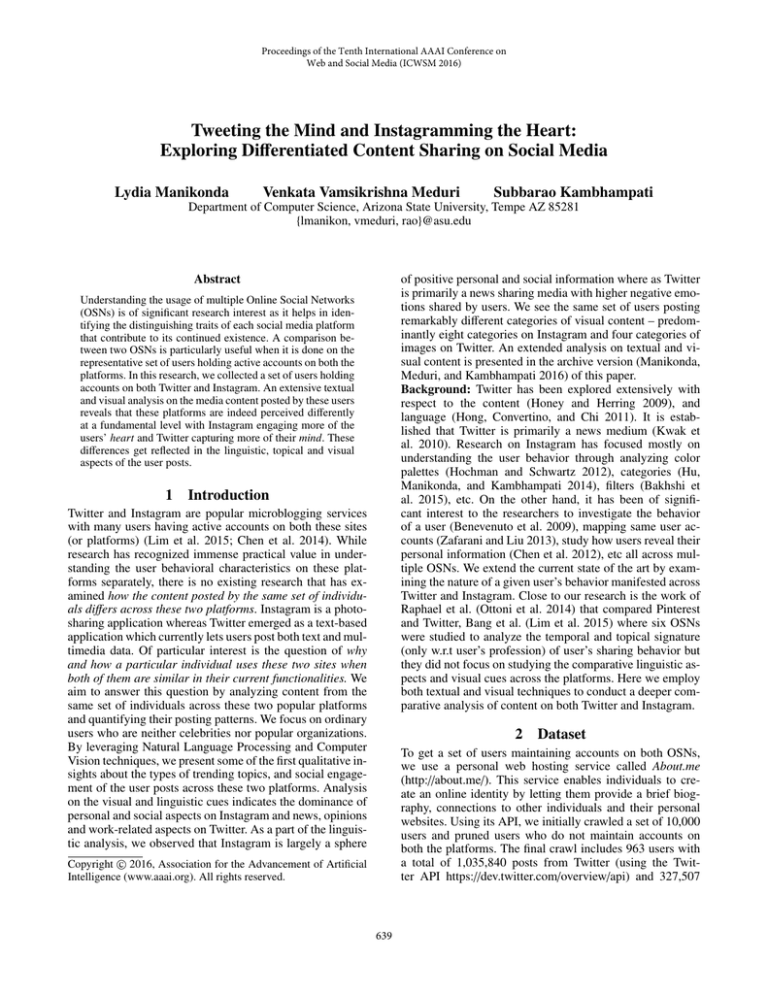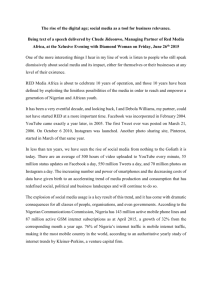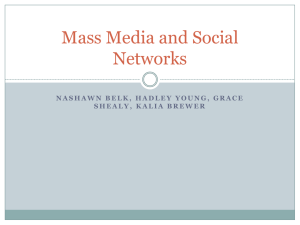
Proceedings of the Tenth International AAAI Conference on
Web and Social Media (ICWSM 2016)
Tweeting the Mind and Instagramming the Heart:
Exploring Differentiated Content Sharing on Social Media
Lydia Manikonda
Venkata Vamsikrishna Meduri
Subbarao Kambhampati
Department of Computer Science, Arizona State University, Tempe AZ 85281
{lmanikon, vmeduri, rao}@asu.edu
of positive personal and social information where as Twitter
is primarily a news sharing media with higher negative emotions shared by users. We see the same set of users posting
remarkably different categories of visual content – predominantly eight categories on Instagram and four categories of
images on Twitter. An extended analysis on textual and visual content is presented in the archive version (Manikonda,
Meduri, and Kambhampati 2016) of this paper.
Background: Twitter has been explored extensively with
respect to the content (Honey and Herring 2009), and
language (Hong, Convertino, and Chi 2011). It is established that Twitter is primarily a news medium (Kwak et
al. 2010). Research on Instagram has focused mostly on
understanding the user behavior through analyzing color
palettes (Hochman and Schwartz 2012), categories (Hu,
Manikonda, and Kambhampati 2014), filters (Bakhshi et
al. 2015), etc. On the other hand, it has been of significant interest to the researchers to investigate the behavior
of a user (Benevenuto et al. 2009), mapping same user accounts (Zafarani and Liu 2013), study how users reveal their
personal information (Chen et al. 2012), etc all across multiple OSNs. We extend the current state of the art by examining the nature of a given user’s behavior manifested across
Twitter and Instagram. Close to our research is the work of
Raphael et al. (Ottoni et al. 2014) that compared Pinterest
and Twitter, Bang et al. (Lim et al. 2015) where six OSNs
were studied to analyze the temporal and topical signature
(only w.r.t user’s profession) of user’s sharing behavior but
they did not focus on studying the comparative linguistic aspects and visual cues across the platforms. Here we employ
both textual and visual techniques to conduct a deeper comparative analysis of content on both Twitter and Instagram.
Abstract
Understanding the usage of multiple Online Social Networks
(OSNs) is of significant research interest as it helps in identifying the distinguishing traits of each social media platform
that contribute to its continued existence. A comparison between two OSNs is particularly useful when it is done on the
representative set of users holding active accounts on both the
platforms. In this research, we collected a set of users holding
accounts on both Twitter and Instagram. An extensive textual
and visual analysis on the media content posted by these users
reveals that these platforms are indeed perceived differently
at a fundamental level with Instagram engaging more of the
users’ heart and Twitter capturing more of their mind. These
differences get reflected in the linguistic, topical and visual
aspects of the user posts.
1
Introduction
Twitter and Instagram are popular microblogging services
with many users having active accounts on both these sites
(or platforms) (Lim et al. 2015; Chen et al. 2014). While
research has recognized immense practical value in understanding the user behavioral characteristics on these platforms separately, there is no existing research that has examined how the content posted by the same set of individuals differs across these two platforms. Instagram is a photosharing application whereas Twitter emerged as a text-based
application which currently lets users post both text and multimedia data. Of particular interest is the question of why
and how a particular individual uses these two sites when
both of them are similar in their current functionalities. We
aim to answer this question by analyzing content from the
same set of individuals across these two popular platforms
and quantifying their posting patterns. We focus on ordinary
users who are neither celebrities nor popular organizations.
By leveraging Natural Language Processing and Computer
Vision techniques, we present some of the first qualitative insights about the types of trending topics, and social engagement of the user posts across these two platforms. Analysis
on the visual and linguistic cues indicates the dominance of
personal and social aspects on Instagram and news, opinions
and work-related aspects on Twitter. As a part of the linguistic analysis, we observed that Instagram is largely a sphere
2
Dataset
To get a set of users maintaining accounts on both OSNs,
we use a personal web hosting service called About.me
(http://about.me/). This service enables individuals to create an online identity by letting them provide a brief biography, connections to other individuals and their personal
websites. Using its API, we initially crawled a set of 10,000
users and pruned users who do not maintain accounts on
both the platforms. The final crawl includes 963 users with
a total of 1,035,840 posts from Twitter (using the Twitter API https://dev.twitter.com/overview/api) and 327,507
Copyright © 2016, Association for the Advancement of Artificial
Intelligence (www.aaai.org). All rights reserved.
639
Twitter Topic Vocabulary
ID Terms
0
stories,
international,
food, web, não, angelo,
já
1
time, people, love, work,
world, social, life
2
3
4
happy, love, home, birthday, weekend, beautiful,
park
más, dı́a, vı́a, gracias, mi,
si, las
#football,
#sports,
#news, #art, facebook,
google, iphone
Instagram Topic Vocabulary
ID Terms
0
#food, delicious, coffee,
sunset, beautiful, happy,
#wedding
1
#streetart,
#brightongraffiti, #belize, #sussex,
#hipstamatic, #urbanart,
#lawton
2
#fashion,
#hair,
#makeup,
#health,
#workout, #vegan, #fit
3
#instagood,
#photooftheday, #menswear,
#style, #travel, #beach,
#summer
4
birthday, beautiful, love,
christmas, friends, fun,
home
Figure 1: Topic distributions of all the user posts on Twitter
and Instagram
Table 1: Words corresponding to the 5 latent topics from
Twitter and Instagram
posts from Instagram (using the Instagram API https://www.
instagram.com/developer/). Each post in this dataset is public and the data include user profiles along with their followers and friends list, tweets (insta posts), meta data for tweets
that include favorites (likes), retweets (Instagram has no explicit reshares; so we use comments as a measure of the attention the post receives), geo-location tagged, date posted,
media content attached and hashtags.
3
3.1
Figure 2: Sorted entropies between the topic distributions of
the user posts on Twitter and Instagram
Text Analysis
platforms by estimating the KL-Divergence between the
topic distributions on each platform. We do this by first
building a unified topic model on the combined corpus of
tweets and captions of Instagram posts. The unified topics
are listed in the description of Figure 3. The resultant entropy plot in Figure 2 shows a significant fraction of the
users posting distinct content on the two platforms. This distinction is statistically significant with an estimated p-value
< 10−15 for each user.
Latent Topic Analysis
To analyze the types of content posted by a user across
Twitter and Instagram, we first mine the latent topics from
the corpus of Twitter (aggregated posts on Twitter of all
users) and corpus of Instagram (aggregated posts on Instagram of all users where we use captions associated with
posts for this analysis). Topic analysis is meaningful as it
is pertinent to understand the reasons behind users joining the two platforms and making posts actively. We use
TwitterLDA (https://github.com/minghui/Twitter-LDA) developed for topic modeling of short text corpora to mine the
latent topics.
The topic vocabulary listed for both the platforms in Table 1 indicates the unique topics for each site as well as the
overlapping topics. For instance topics 0 and 4 on Instagram
are similar to the topics 1 and 2 on Twitter. However, a significant difference is that Instagram is predominantly used
to post about art, food, fitness, fashion, travel, friends and
family but Twitter hosts a significantly higher percentage of
posts on sports, news and business. Another notable difference is that the vocabulary from non-English language posts
like French and Spanish is higher on Twitter as compared
to the captions on Instagram mostly using English as the
language medium. The topic distributions obtained from the
two corpora listed in Figure 1 show that friends and food are
the most frequently posted topics on Instagram as against
sports and news followed by work and social life being popular on Twitter.
To further validate the observations made about the distinctive topical content across the two platforms, we compared the topic distributions for each individual on the two
3.2
Social Engagement
Since our findings revealed that the topics across the two
platforms are significantly different, we wanted to investigate how the posts made by the same user engage other individuals on the two sites. We define the social engagement
as the attention received by a user’s post on the social media platform. It can be quantified in various ways varying
from the sum of likes and comments on Instagram to the
sum of favorites and reshares on Twitter. For each topic in
the unified topic model for both Twitter and Instagram, the
logarithmic frequency of posts is plotted against the magnitude of social engagement that is binned to discrete ranges.
The results are shown in Figure 3.
An interesting observation is that the socially engaging
topics in the combined model are same as the overlapping
topics from the topic models built in isolation on the Twitter and Instagram posts (Figure 1). The dominating topic on
Twitter is about sports, news and business and on Instagram
it is about love, fashion and food. Surprisingly, we found that
the overlapping topics (Topics 2 and 3) focusing on social
and personal life fetched predominant social engagement on
both the platforms. Though the dominating topic (commonly
640
(a) Twitter
(b) Instagram
Figure 3: Social Engagement Vs Post Frequency where the topics are – Topic 0:{people, life, world, social, app, game, business},
Topic 1:{stories, artists, #lastfm, level, #football, #sports, news}, Topic 2:{birthday, beautiful, work, weekend, park, dinner,
christmas}, Topic 3:{ yang, run, #fitness, #runkeeper, #art, sale, #menswear}, Topic 4:{#instagood, #photooftheday, #love, más,
#fashion, #travel, #food}
Platform
Twitter
Instagram
0.60
0.19
0.49
0.19
0.15
0.14
0.05
0.17
0.30
0.21
0.1
0.21
0.81
0.6
0.08
0.07
0.16
0.5
0.93
0.06
0.04
0.2
Emotionality
Negemo
Posemo
Social Relationships
home
family
friend
humans
Figure 4: Distributions of Followers/Followings vs Media
Individual Differences
work
bio
swear
death
gender
posted) and the most engaging topic (commonly liked) happen to be the same on Instagram, this phenomenon is not
applicable to Twitter.
A notable difference between the platforms with respect
to social engagement is that the magnitude of attention received for Instagram posts is significantly higher than the
level of attention received on Twitter. We can see this from
the ranges plotted on the x-axes in Figure 3. This observation is consistent regardless of the activity level of a user.
Even when a user is more active (Figure 4) on Twitter than
Instagram, the observation of higher social engagement on
Instagram on an absolute scale holds. A possible explanation
to this is that the users on Twitter use it as a news source to
read informative tweets but not necessarily all of the content
that is read will be “liked”.
On average, there are 30% more hashtags for a Twitter
post compared to an Instagram post (Pearson correlation coefficient = 0.34 between distributions with p-value < 10−15 ).
This may also indicate that on Instagram since the main content is image, textual caption may not receive as much attention from the user.
3.3
Table 2: Linguistic attributes across Twitter vs Instagram.
Each value indicates the fraction of a post belonging to the
corresponding attribute
It is clear from Table 2 that posts on Twitter have more
negative emotions and contain more work-related and swear
words. In contrast, positive social patterns are more evident
on Instagram. By relating these results to the topic analysis
results in the previous section, we note that on Instagram
users share more light-hearted happy personal updates.
4
Visual Analysis
This section develops a better understanding of the types of
photos individuals post on Twitter in comparison with their
Instagram posts. To achieve this we employ computer vision
techniques mainly in terms of visual categories (kinds of
photos).
Linguistic Nature
To characterize and compare the type of language used on
both platforms, we use the psycholinguistic lexicon LIWC
((http://liwc.wpengine.com/)) on the text associated with
Twitter posts and Instagram posts. We obtain measures of
attributes related to user behavior – emotionality (how people are reacting to different events), social relationships
(friends, family, other humans) and individual differences
(attributes like bio, gender, age, etc).
4.1
Visual Categories
We further investigated if the visual categories of the posts
made on Twitter and Instagram are different. We first sampled two sets of 5000 images from both platforms separately.
Using the OpenCV library (http://opencv.org/) on these two
datasets, we extracted Speeded Up Robust Features (SURF)
for each image. We used the vector quantization approach
641
5
(a)
(b)
(c)
In this paper, we presented a detailed comparison of the textual and visual analysis of the content posted by the same set
of users on both Twitter and Instagram. Some of the insights
obtained from linguistic analysis reveal the fundamental differences in the thinking style and emotionality of the users
on these two platforms and how the posts receive varying
degrees of attention as per the underlying topics. The visual analyses with respect to categories and color palettes
indicate that the pictures posted on Instagram contains more
selfies and photos with friends where as Twitter contains
more about user opinions in the form of captioned photos
– memes, quotes, etc. We observed that the differences are
deeply rooted in the very intention with which users post
on these platforms with Twitter being a venue for serious
posts about news, opinions and business life while Instagram serves as the host for light-hearted personal moments
and posts on leisure activities. Interestingly, user posts on
Instagram seem to receive significantly more attention than
Twitter.
Acknowledgements: This research is supported in part by
a Google research award, the ONR grants N00014-13-10176, N00014-13-1-0519 and N00014-15-1-2027, and the
ARO grant W911NF-13- 1-0023. We thank Reza Zafarani
for providing us the initial seed set of users.
(d)
Figure 5: Subcategories of activity: a) TV shows, b) Running, c) Conferences, d) Live shows
(a)
(b)
Conclusions
(c)
Figure 6: Subcategories of captioned photos: a) Snapshots,
b) Memes, c) Quotes
References
Bakhshi, S.; Shamma, D.; Kennedy, L.; and Gilbert, E. 2015. Why
we filter our photos and how it impacts engagement. In ICWSM.
Benevenuto, F.; Rodrigues, T.; Cha, M.; and Almeida, V. 2009.
Characterizing user behavior in online social networks. In IMC.
Chen, T.; Kaafar, M. A.; Friedman, A.; and Boreli, R. 2012. Is
more always merrier?: A deep dive into online social footprints. In
WOSN.
Chen, Y.; Zhuang, C.; Cao, Q.; and Hui, P. 2014. Understanding
cross-site linking in online social networks. In SNAKDD.
Hochman, N., and Schwartz, R. 2012. Visualizing instagram: Tracing cultural visual rhythms. In ICWSM.
Honey, C., and Herring, S. 2009. Beyond microblogging: Conversation and collaboration via twitter. In HICSS, 1–10.
Hong, L.; Convertino, G.; and Chi, E. 2011. Language matters in
twitter: A large scale study. In ICWSM.
Hu, Y.; Manikonda, L.; and Kambhampati, S. 2014. What we instagram: A first analysis of instagram photo content and user types.
In ICWSM.
Kwak, H.; Lee, C.; Park, H.; and Moon, S. 2010. What is twitter,
a social network or a news media? In WWW.
Lim, B. H.; Lu, D.; Chen, T.; and Kan, M.-Y. 2015. #mytweet
via instagram: Exploring user behaviour across multiple social networks. In ASONAM.
Manikonda, L.; Meduri, V.; and Kambhampati, S. 2016. Tweeting the mind and instagramming the heart: Exploring differentiated
content sharing on social media. CoRR abs/1603.02718.
Ottoni, R.; Casas, D. L.; Pesce, J. P.; Meira Jr., W.; Wilson, C.; Mislove, A.; and Almeida, V. 2014. Of pins and tweets: Investigating
how users behave across image- and text-based social networks. In
ICWSM.
Zafarani, R., and Liu, H. 2013. Connecting users across social
media sites: A behavioral-modeling approach. In KDD.
Figure 7: Photo categories on Twitter vs Instagram
on these features that eventually converted each image into
a codebook format. Using the codebook, we clustered images using k-means algorithm (best value of k is found by
SSE (Sum of Squared Error)) which are refined and considered as the overall visual themes or categories.
Visual categories on Instagram agree with our previous
work (Hu, Manikonda, and Kambhampati 2014) which detected eight different categories of images. We tried to categorize the Twitter images into the same format as Instagram images. This shows that there are four prominent cluster categories on Twitter. Figure 7 shows that the percentage
of photos in the activity category outnumbered any other
category followed by captioned photos. To better understand the kinds of activities and captions shown in these
two sections, we sampled around 200 images and asked
the two researchers to label them manually into different
sub-categories. Figure 5 indicates the most popular subcategories in the activity category – news, events (football
games, concerts, conferences) and races. Figure 6 indicates
that majority of the captioned photos are snapshots, memes,
and quotes or opinions. These categories show that the topics of photos on Twitter are mainly related to news, opinions or other general user interests. In contrast, on Instagram
users seem to mainly share their joyful and happy moments
of their personal lives.
642



